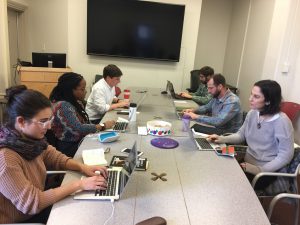Praxis on Choosing a Subject of Study, or, How did we come to the Kardashians?

Keeping up with the Praxis 2016-2017 cohort.
Unlike previous cohorts of Praxis, we did not have a topic or project assigned to us when we came into the program. Rather, our fearless leaders at the Scholars Lab took a chance. Our assignment: “time, temporality, go!” The first impulse was to directly challenge the traditional conceptions of time, linear time. Our cohort, made up of scholars of English literature, Russian literature, US history, and European art history, came to the topic of cyclical time from multiple different viewpoints. Joseph, whose academic work focuses on music and collective memory, immediately grasped the nature of cyclical time. Similarly, Alyssa and Jordan understood cyclical time’s ramifications in memory, story telling, and formal literary construction. I, on the other hand, an art historian who works with ephemeral objects, objects that are seen by humans and then over time melt, break, and disintegrate… I had trouble wrapping my head around the concept. Once an object is gone, how can it be viewed and perceived by the viewer and human subject? After meetings in which we discussed Gilles Deleuze, George Kubler, Albert Einstein, among others, I finally found myself opening up to the fact that time, as we humans perceived, is a construction—one that I was having trouble removing myself from because of the conditioning I had received as a member of a western-centric, euro-centric society. As an art historian, my views had been directly—if unknowingly—shaped by the history of my field. Emmanuel Kant, after all, established the notion that time is something we experience. A key step to this breakthrough was our discussion of the density of time and brainstorming its many variations:
-
literary time
-
cinematic time
-
visual time
-
collective memory
-
nostalgia
As a group, we kept coming back to the topic of collective memory and nostalgia. Where was the line between the two? Was nostalgia a conservative form of collective memory? The concept of “radical nostalgia” challenged this notion. Radical, or insurgent, nostalgia, reframes nostalgia as an act not inherently conservative, especially when harnessing radical or progressive events and movements of the past (see Peter Glazer’s Radical Nostalgia: Spanish Civil War Commemoration in Americ__a, 2005). In our discussion, it became radically apparent that our own experience with the development of contemporary collective memory, how it was shaped in our daily lives, was the product of one dominant force: social media.
We were in the trenches of the 2016 election cycle. Donald Trump’s tweets were in the news everyday. Conservatives were accusing Facebook’s content editors of having a liberal bias. How was social media shaping how we perceived the 24-hour news cycle, and thereby our collective understanding of culture and politics? How could we visualize the social media landscape? How could we use social media as a data set? Was there a cohesive data set across all media that we could mine for a productive analysis of social media usage and its cultural ramifications?
Enter the Kardashian family empire. Reality TV, tabloid coverage, Twitter, Instagram, Snapchat, iPhone and android apps, online blogs… in many ways it emerged as a story of archive creation, expansive real time narrative construction, and yes, even a study of collective memory.
Who are the Kardashians? The Kardashians are an Armenian-American family living in Los Angeles headed by the matriarch Kris Jenner, who married Robert Kardashian in 1978 (divorced in 1991) and later the Olympian Bruce Jenner, now Caitlyn Jenner, in 1991 (divorced in 2015). The family first came to public attention in 1995, during the high profile murder trial of O.J. Simpson during which Robert Kardashian, was part of the defense’s legal team. They found themselves in the tabloids again in 2007 when a sex tape was leaked of daughter Kim Kardashian and her then-boyfriend Ray J. Taking advantage of such notoriety the family debuted their reality television series Keeping Up with the Kardashians later that year. By embracing nearly ever media platform at their disposal, the Kardashians have promoted their brand and developed their family narrative in real time, garnering interest in how they will ‘cover’ certain life events in their TV show airing months later.
Commenting on news events, promoting awareness of the Armenian genocide, while producing extravagant television specials, the Kardashian family has harnessed the 24/7 media landscape in new and unprecedented ways; their rise to fame paralleling the rise of social media and the internet as we know it.
Stay tuned as we, the Praxis 2016-2017 cohort, dissect and analyze the Kardashian media ecology….
